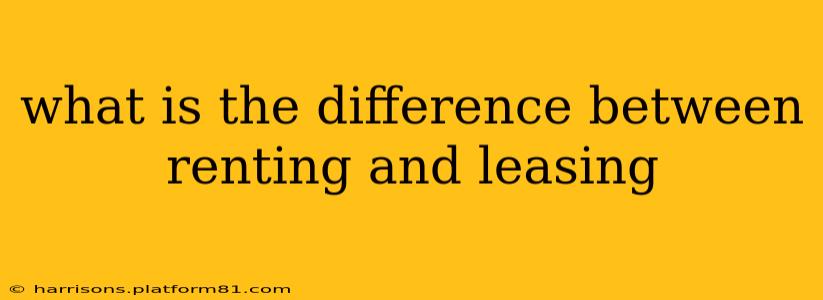What's the Difference Between Renting and Leasing?
The terms "renting" and "leasing" are often used interchangeably, leading to confusion. While they both involve the temporary use of property in exchange for payment, there are key differences, particularly in legal implications and the length of the agreement. Understanding these nuances is crucial before committing to either a rental or a lease agreement.
What is Renting?
Renting typically refers to a shorter-term agreement, often month-to-month. It's characterized by more flexibility for both the tenant (renter) and the landlord. Landlords often have the ability to increase rent with reasonable notice, and tenants can typically terminate the agreement with similar notice, though specific notice periods vary by jurisdiction and the terms of the rental agreement. Renting usually involves less paperwork and a simpler process compared to leasing. Think of renting a car for a weekend – it's a short-term arrangement.
What is Leasing?
Leasing usually involves a longer-term agreement, often spanning several months or even years. This agreement typically outlines specific terms and conditions, including rent amounts, lease duration, and responsibilities of both the tenant (lessee) and the landlord (lessor). Lease agreements are more formal and legally binding than rental agreements. Modifications to the agreement require mutual consent and are typically documented in writing. Breaking a lease before its expiration date can result in penalties for the lessee. Think of leasing an apartment for a year or signing a contract for a new car – it's a longer-term commitment.
What are the Key Differences Summarized?
| Feature | Renting | Leasing |
|---|---|---|
| Duration | Short-term, often month-to-month | Long-term, often several months or years |
| Agreement | Informal, less legally binding | Formal, legally binding contract |
| Flexibility | High for both tenant and landlord | Lower for both tenant and landlord |
| Termination | Easier, typically with notice | More difficult, potentially with penalties |
| Rent Changes | More frequent and easier to adjust | Less frequent, requires agreement changes |
What is the difference between a lease and a rental agreement?
This is often the core of the confusion. The distinction is mostly one of formality and length. A rental agreement is generally shorter-term and less formal, often with fewer legally binding clauses. A lease is a more formal, longer-term contract with detailed specifications and legal protections for both parties. However, the specific legal terminology and distinctions can vary by location, so it's always best to carefully review the terms of your specific agreement regardless of whether it's called a "lease" or a "rental agreement".
How do I know if I'm renting or leasing?
The best way to know is to carefully read the agreement. Look for the length of the agreement, the specifics of the terms, and the legal clauses included. If the agreement is for a short term and has less detail, it's more likely a rental agreement. If it's a longer-term agreement with more specifics and legal clauses, it's more likely a lease.
Which is better, renting or leasing?
The best option depends on your individual circumstances and priorities. Renting offers greater flexibility but may result in higher costs over time due to potential rent increases. Leasing provides stability and predictability but sacrifices flexibility. Consider your lifestyle, financial situation, and long-term plans when making your decision.
This detailed comparison should clarify the subtle yet important distinctions between renting and leasing, empowering you to make informed decisions about your housing or property acquisition. Remember to always consult with a legal professional if you have specific questions about your lease or rental agreement.
